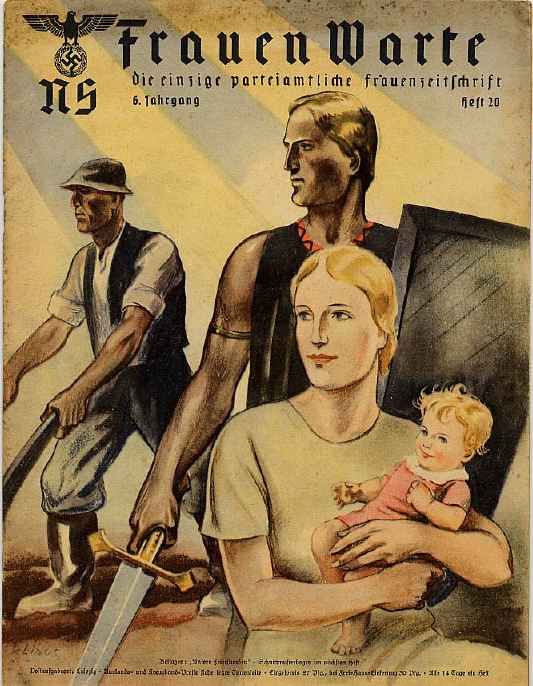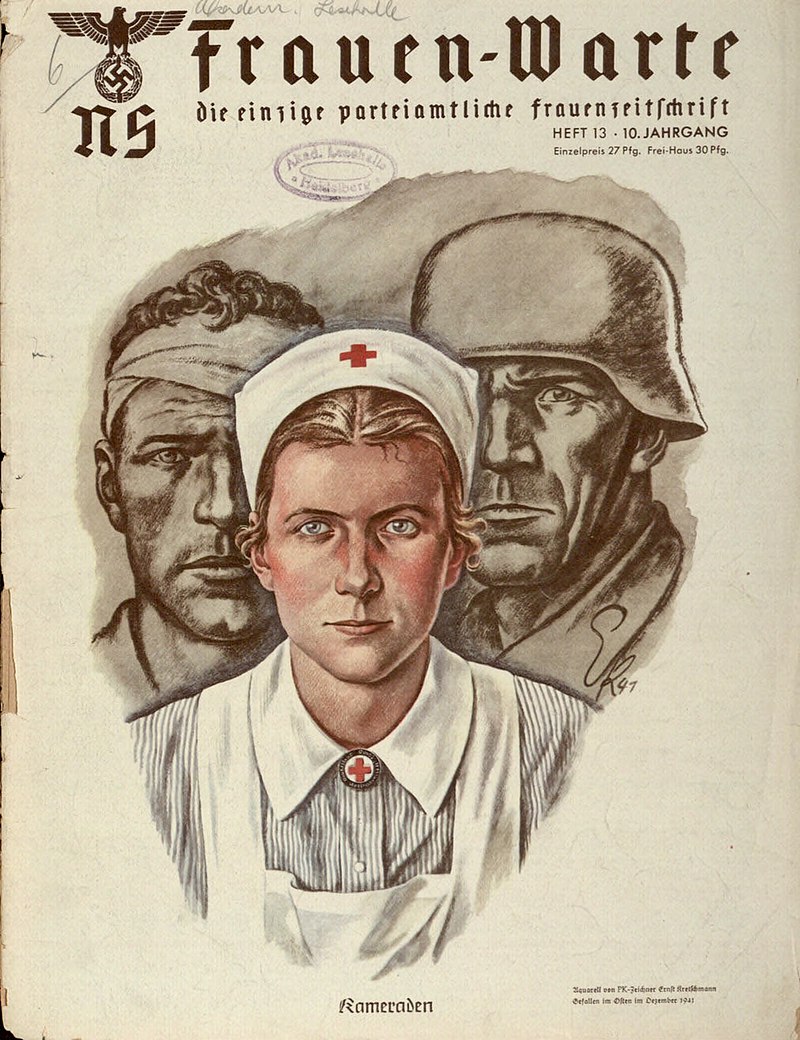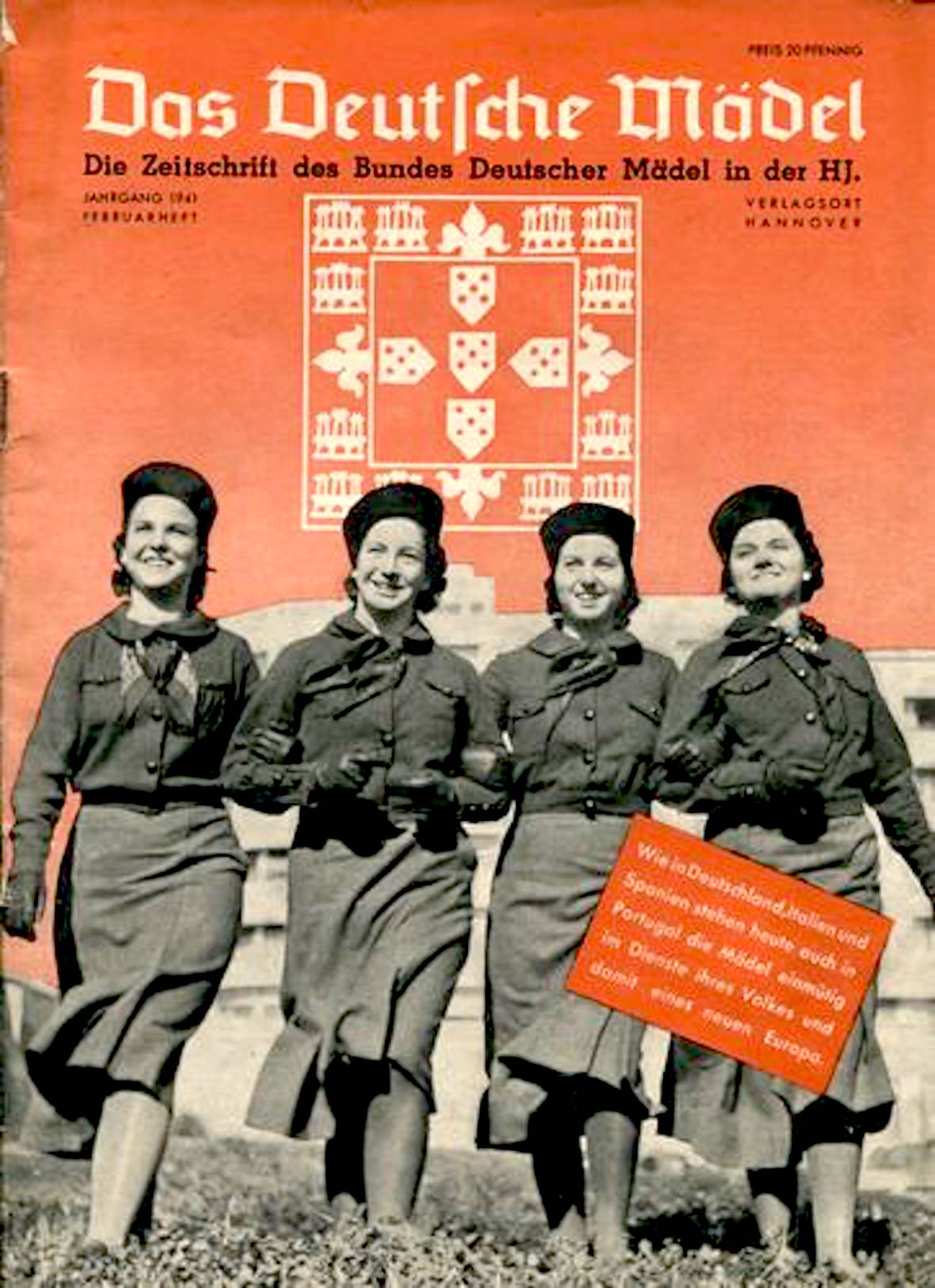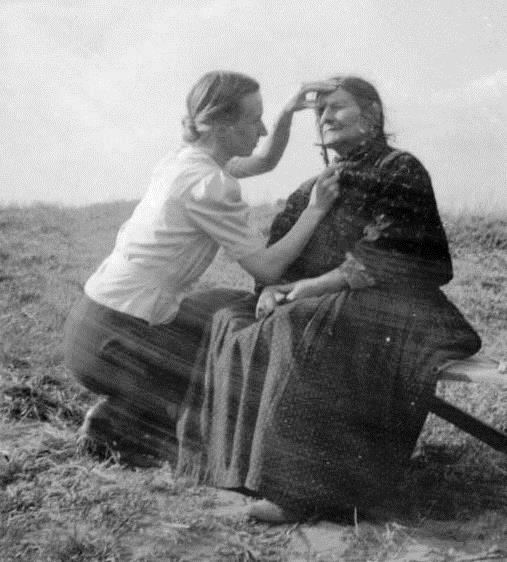Women in the Nazi regime



(right) Frauen-Warte No. 10, 1942. 'Comrades', propaganda drawing by Ernst Kretschmann, fallen on the Eastern Front in 1941.



(right) Frauen-Warte No. 10, 1942. 'Comrades', propaganda drawing by Ernst Kretschmann, fallen on the Eastern Front in 1941.
◎ナチスにおける女性の位置
(1933)7月結婚奨励法の可決。ベビー・ボーナ ス。中絶手術の実質的禁止。ナチの政権掌握の直前には、10万人の女性教師と3,000人の女性医師がいたが、最終的に解雇か辞任に追いやられる。 (1936年以降は禁止。大学は10%まで)。その理由は、「ナチズムにおけるあるべき女性観は「価値ある血統の血を増殖させる」ために多産する「控えめ で、従順で、献身的な主婦」が求められるというものであった(→「ナチスの女性政策」 「【年表・地図】ナチズムとジェンダー」)。
NS-Frauen-Warte(ナチ発行『国家社
会主義女性モニター』誌)とDas Deutsche Mädel(『ドイツ女子』誌)
| The
NS-Frauen-Warte
("National Socialist Women's Monitor") was the Nazi magazine for
women.[1] Put out by the NS-Frauenschaft, it had the status of the only
party approved magazine for women[2] and served propaganda purposes,
particularly supporting the role of housewife and mother as
exemplary.[3] |
NS-Frauen-Warte』(国家社会主義女性モニ
ター)は、ナチスの女性向け雑誌である。NS-Frauenschaftが発行したこの雑誌は、党が認めた唯一の女性向け雑誌という位置づけで、特に主婦
と母親の役割を模範的に支持するプロパガンダの役割を果たした。 |
| NS-Frauen-Warte
was first published in 1934.[4] The magazine was published
biweekly[4][5] and had articles on a wide range of topics of interest
to women and included sewing patterns.[6] Its articles included such topics as the role of women in the Nazi state, Germanization efforts in Poland, the education of youth, the importance of play for children, claims that the United Kingdom was responsible for the Second world war, and that Bolshevism would destroy Germany and Europe if the Soviet Union was not defeated.[7] It defended anti-intellectualism,[8] highlighted the achievements of Nazi women and how the system had benefited females,[9] and discussed bridal schools.[10] Poetry describing children as a form of immortality.[11] During wartime it urged women to have children,[12][13] to join in the war effort either in employment or in Frauenschaft from the very beginning,[14] and to greater efforts in total war.[15] Its April 1940 cover showed a peasant woman plowing before a factory, with a soldier's face looming overhead.[16] It depicted accounts of women as nurses during the war, although chiefly as a vehicle for anti-Bolshevist propaganda.[17] It was predominantly a woman's magazine despite containing propaganda; this contrasts sharply with Das deutsche Mädel, which lay emphasis on the strong and active German woman.[18] The 1939 circulation of the magazine was 1.9 million copies.[4] The magazine ceased publication in 1945.[4] The University of Heidelberg digitized the issues between 1941 and 1945 of the magazine.[4] |
NS-Frauen-Warteは、1934年に創刊されました。この
雑誌は隔週で発行され、女性が関心を持つ幅広い話題に関する記事が掲載され、裁縫の型紙も含まれていた。 ナチス国家における女性の役割、ポーランドにおけるドイツ化の取り組み、青少年の教育、子供たちの遊びの重要性、第二次世界大戦の責任はイギリスにあると の主張、ソ連を倒さなければボルシェビズムがドイツとヨーロッパを破壊するといったテーマが掲載された。反知性主義を擁護し、ナチス女性の功績とその制度 がいかに女性に恩恵を与えたかを強調し、ブライダルスクールについても触れている。子供を不滅の存在として描写する詩。戦時中、この雑誌は、女性に子ども を産むこと、最初から女性フェローシップすなわちフラウエンシャフト(Frauenschaft)を通して戦争に参加すること、そして総力戦でより大きな 力を発揮することを促した。1940年4月の表紙は、工場の前で耕す農民の女性と、頭上に迫る兵士の顔であった。戦時中は、主に反ボルシェビズムのプロパ ガンダの手段として、看護婦としての女性の姿を描いている。 この雑誌は、プロパガンダを含んでいたにもかかわらず、主に女性誌であった。この点は、強く活発なドイツ女性を強調した『Das deutsche Mädel』とは対照的である。1939年の発行部数は190万部であった。1945年に廃刊となった。 ハイデルベルク大学では、この雑誌の1941年から1945年までの号をデジタル化した。 |
| Das
Deutsche Mädel
(German: [das ˈdɔʏtʃə ˈmɛːdl̩]; The German Girl) was the Nazi
propaganda magazine aimed at girls, particularly members of League of
German Girls.[1] In fact, it was the official organ of the
League.[2][3] The magazine was published on a monthly basis between
1933 and 1942.[2][4] Unlike the adventure orientation of Der Pimpf, intended for Hitler Youth, Das deutsche Mädel urged hiking, tending the wounded, hard work in factories, and preparing for motherhood.[1] On the other hand, in contrast to the woman's magazine with some propaganda, NS-Frauen-Warte, it lay far more emphasis on the strong and active German woman; health, education, service, and sports all featured, and famous women depicted included doctors, athletes, poets, and pilots.[5] Articles in it included describing a speech by Jutta Rüdiger when she was appointed to lead The League of German Girls,[6] telling the girls who had just joined the Jungmädelbund of their duties to Germany,[7] and a story of how Young Girls had ensured that a dead father's promise to his son was fulfilled.[8] |
Das Deutsche Mädel (The
German Girl)
は、少女、特にドイツ少女同盟のメンバーを対象としたナチのプロパガンダ雑誌である。実際、この雑誌はドイツ少女同盟の公式機関紙であった。1933年か
ら1942年にかけて月刊誌として発行された。 ヒトラーユーゲント向けの『ピンプフ』の冒険志向とは異なり、『ダス・ドイッチェ・メーデル』はハイキング、負傷者の世話、工場での重労働、母になる準備 などを促していた。一方、プロパガンダを含む女性誌『NS-Frauen-Warte』とは対照的に、強く活発なドイツ女性をはるかに強調し、健康、教 育、奉仕、スポーツなどが取り上げられ、医師、運動選手、詩人、パイロットなどの有名な女性が描かれている。 ユッタ・リュディガーがドイツ少女同盟の指導者に任命されたときの演説や、ユングメーデルブントに加入したばかりの少女たちにドイツへの義務を伝える記 事、死んだ父親と息子の約束を若い少女たちが果たした話などが掲載されている。 www.DeepL.com/Translator(無料版)で翻訳しました。 |
| Der Pimpf (German:
[deːɐ̯ ˈpɪmpf]) was the Nazi magazine for boys, particularly those in
the Deutsches Jungvolk, with adventure and propaganda.[1] It first
appeared in 1935 as Morgen, changing its name to Der Pimpf in 1937; its
publication ceased in July, 1944.[1] It included adventures of troops of Hitler Youth.[2] Its last issue urged the boys to model themselves on the SS, and spoke of the SS Division "Hitler Jugend".[3] The female counterpart, Das deutsche Mädel, lacked this emphasis on adventure.[4] The word Pimpf is slang for any member of the German Youth Movement, but later especially of the Deutsches Jungvolk, the youngest tier of the Hitler Youth. Its meaning in Upper German is "boy", "little rascal", "scamp", or "rapscallion", originally "little fart".[5] |
Der
Pimpf(ドイツ語:[deːɐ̯)は、ナチスの少年向け雑誌で、特にDeutsches
Jungvolkの少年たちのための冒険とプロパガンダを掲載した雑誌である。1935年に『Morgen』として創刊され、1937年に『Der
Pimpf』と改題、1944年7月に廃刊となった。 ヒトラーユーゲント部隊の冒険が掲載されていた。最終号では、少年たちに親衛隊を模範とするよう促し、親衛隊の「ヒトラー・ユーゲント」師団について述べ た。 女性向けの『Das deutsche Mädel』には、このような冒険を強調する要素はなかった。 Pimpfという言葉は、ドイツ青年運動、特にヒトラーユーゲントの最年少層であるDeutsches Jungvolkのメンバーに対するスラングである。ドイツ語では「少年」、「小悪党」、「悪党」、「屑鉄」などを意味し、もともとは「小さなオナラ」で あった。 |
◎Mothers in the
fatherland : women, the family, and Nazi politics / Claudia
Koonz, Routledge , 2013; Originally published in Great Britain in 1987
by Jonathan Cape, Reprint of the paperback ed. published in 1988 by
Methuen, London/ 父の国の母たち : 女を軸にナチズムを読む / クローディア・クーンズ著 ;
翻訳工房「とも」訳, 時事通信社 , 1990
この書は、ヒトラーの女性局局長の驚くべきインタ ビューを含む広範な調査から、ナチズムの台頭において、支持者、犠牲者、抵抗者として女性が果たした役割を追跡している。本書は、ドイツ社会のあらゆるレ ベルにおける女性の地位、責任、抵抗、犠牲を理解するための重要な貢献であり、驚くべき皮肉と逆説的道徳、妥協と勇気、服従と生存の記録である。
序文
エピローグ
◎ドイツの人種衛生学(日本語名称は民族衛生学であ るが、言語は、ドイツ語のRassenhygiene、英語のRacial hygieneに該当するので、以下は人種衛生学という)
| The term racial
hygiene was used to describe an approach to eugenics in the early 20th
century, which found its most extensive implementation in Nazi Germany
(Nazi eugenics). It was marked by efforts to avoid miscegenation,
analogous to an animal breeder seeking purebred animals. This was often
motivated by the belief in the existence of a racial hierarchy and the
related fear that "lower races" would "contaminate" a "higher" one. As
with most eugenicists at the time, racial hygienists believed that the
lack of eugenics would lead to rapid social degeneration, the decline
of civilization by the spread of inferior characteristics. |
人種衛生または人種衛生学という言葉は、20世紀初頭にナチス・ドイツ
で最も大規模に行われた優生学(ナチス優生学)を表す言葉として使われている。これは、動物の繁殖家(ブリーダー)が純血種の動物を探すのに似ていて、混
血を避けようとする努力が特徴的である。これは、人種的なヒエラルキーが存在するという信念と、「低い人種」が「高い人種」を「汚染」してしまうという恐
怖からしばしば動機づけられていた。当時の優生学者がそうであったように、人種衛生学者も優生学の欠如は急速な社会退廃、すなわち劣った特性の拡散による
文明の衰退につながると考えていた。 ※この用語は、1895年にドイツの医学者アルフレッド・プレッツ(Alfred Ploetz)が 提唱したものである。 |
| The German eugenicist Alfred
Ploetz introduced the term "racial hygiene" (Rassenhygiene) in 1895 in
his Racial Hygiene Basics (Grundlinien einer Rassenhygiene). He
discussed the importance of avoiding "counterselective forces" such as
war, inbreeding, free healthcare for the poor, alcohol and venereal
disease.[1] In its earliest incarnation it was more concerned by the
declining birthrate of the German state and the increasing number of
mentally-ill and disabled people in state-run institutions (and their
costs to the state) than it was by the "Jewish question" and the
"degeneration of the Nordic race" (Entnordung) which would come to
dominate its philosophy in Germany from the 1920s to the Second World
War.During the last years of the 19th century, the German racial
hygienists Alfred Ploetz and Wilhelm Schallmayer regarded certain
people as inferior, and they opposed their ability to procreate. These
theorists believed that all human behaviors, including crime,
alcoholism and divorce, were caused by genetics.[2] |
ドイツの優生学者アルフレッド・プレッツは、1895年に『人種衛生の
基本』(Grundlinien einer
Rassenhygiene)の中で「人種衛生」(Rassenhygiene)という言葉を紹介した。彼は、戦争、近親交配、貧困層への無料医療、アル
コール、性病などの「逆選択的な力」を避けることの重要性を論じた [1]。
初期には、1920年代から第二次世界大戦までのドイツでその思想を支配することになる「ユダヤ人問題」や「北欧人種の退化」(Entnordung)よ
りも、ドイツ国家の出生率の低下や国家運営の施設における精神疾患者や障害者の増加(およびその国家への負担)に関心を寄せていた。
19世紀末、ドイツの人種衛生学者アルフレッド・プレッツとヴィルヘルム・シャルマイヤーは、特定の人々を劣った存在とみなし、彼らの子孫を残す能力に反
対していた。これらの理論家は、犯罪、アルコール依存症、離婚など、人間のすべての行動は遺伝によって引き起こされると考えていた[2]。 |
| During the 1930s and 1940s,
institutes in Nazi Germany studied genetics, created genetic registries
and researched twins. Nazi scientists also studied blood, and developed
theories on the supposed racial specificity of blood types, with the
goal of distinguishing an "Aryan" from a Jew by examining their blood.
In the 1940s, Josef Mengele, a doctor in the Schutzstaffel (SS),
provided human remains that were taken from Auschwitz – blood, limbs
and other body parts – to be studied at the institutes. Harnessing
racial hygiene as a justification, the scientists used prisoners from
Auschwitz and other concentration camps as test subjects for their
human experiments.[2] |
1930年代から1940年代にかけて、ナチスドイツの研究所では遺伝
学の研究、遺伝子登録の作成、双子の研究などが行われた。ナチスの科学者たちは血液についても研究し、血液型を調べることで「アーリア人」と「ユダヤ人」
を区別することを目的に、人種的特異性を持つ血液型に関する理論を構築した。1940年代、親衛隊の医師ヨーゼフ・メンゲレは、アウシュビッツから持ち出
された人骨(血液、手足、体の一部)を研究所に提供し、研究させた。科学者たちは、人種的衛生を正当化するために、アウシュビッツや他の強制収容所の囚人
たちを人体実験の被験者としたのである[2]。 |
| In Nazi propaganda, the term
"race" was often interchangeably used to mean the "Aryan" or Germanic
"Übermenschen", which was said to represent an ideal and pure master
race that was biologically superior to all other races.[3] In the
1930s, under eugenicist Ernst Rüdin, National Socialist ideology
embraced this latter use of "racial hygiene", which demanded Aryan
racial purity and condemned miscegenation. That belief in the
importance of German racial purity often served as the theoretical
backbone of Nazi policies of racial superiority and later genocide. The
policies began in 1935, when the National Socialists enacted the
Nuremberg Laws, which legislated racial purity by forbidding sexual
relations and marriages between Aryans and non-Aryans as Rassenschande
(racial shame). |
ナチスのプロパガンダでは、「人種」という言葉はしばしば「アーリア
人」またはゲルマン人の「Übermenschen(優越人種)」
を意味するものとして交換可能として使われ、それは他のすべての人種よりも生物学的に優れた理想的で純粋な支配階級の象徴であるとされた[3]。1930
年代、優生学者エルンスト・リュディンのもと、国家社会主義思想はこの後者の「人種衛生」を取り入れ、アーリア人種の純度を求め、異種交配を非難するよう
になった。ドイツの人種的純度の重要性に対するこの信念は、しばしばナチスの人種的優越政策とその後の大量虐殺政策の理論的バックボーンとして機能した。
この政策は1935年に国家社会党がニュルンベルク法を制定し、アーリア人と非アーリア人の性的関係や結婚をRassenschande(人種の恥)とし
て禁止し、人種的純度を法制化したことから始まった。 |
 Eva
Justin checking the facial characteristics of a Romani woman, as part
of her "racial studies" Eva
Justin checking the facial characteristics of a Romani woman, as part
of her "racial studies" Eva Justin (23 August 1909 – 11 September 1966) was a German anthropologist who was active during the Nazi era. She specialised in scientific racism. Her work contributed to the Nazi crimes against the Sinti and Roma peoples. Born in Dresden in 1909, the daughter of a railroad official, Eva Justin served as an assistant to Nazi psychologist Robert Ritter.Justin originally trained as a nurse, and received her doctorate in anthropology from the University of Berlin in 1943, despite not having followed the normal university procedure to do so. Eugen Fischer mentored her through her doctoral thesis and final exams, and ethnologist Richard Thurnwald was a reviewer.[2] Justin was one of the first registered nurses to earn a PhD. Speaking Romani, she earned the trust of Roma and Sinti people. Her doctoral dissertation was titled "Lebensschicksale artfremd erzogener Zigeunerkinder und ihrer Nachkommen" ("Biographical destinies of Gypsy children and their offspring who were educated in a manner inappropriate for their species"). |
エヴァ・ユスティン(1909年8月23日 -
1966年9月11日)は、ナチス時代に活躍したドイツの人類学者である。専門は科学的人種差別。彼女の研究は、シンティとロマの人々に対するナチスによ
る犯罪行為に貢献した。1909年、鉄道職員の娘としてドレスデンに生まれ、ナチスの心理学者ロベルト・リッターの助手を務めた。看護婦としての訓練を受
け、1943年に大学の正規の手続きを踏まずにベルリン大学で人類学の博士号を取得した。オイゲン・フィッシャーが博士論文と最終試験を指導し、民族学者
のリチャード・サーンワルドが査読を行った[2]。ロマ語を話す彼女は、ロマやシンティの人々から信頼を得ていた。博士論文のタイトルは
「Lebensschicksale artfremd erzogener Zigeunerkinder und ihrer
Nachkommen」(「ジプシーの子供とその子孫の運命は、その種に不適切な方法で教育されたものである」)であった(→「エヴァ・ユスティンとロマ民族」)。 |
◎カイザー・ヴィルヘルム人類学・人類遺伝学・優生 学研究所(Kaiser Wilhelm Institute of Anthropology, Human Heredity, and Eugenics)→「カイザー・ヴィルヘルム科学振興機構」
Links
リンク
文献
その他の情報


